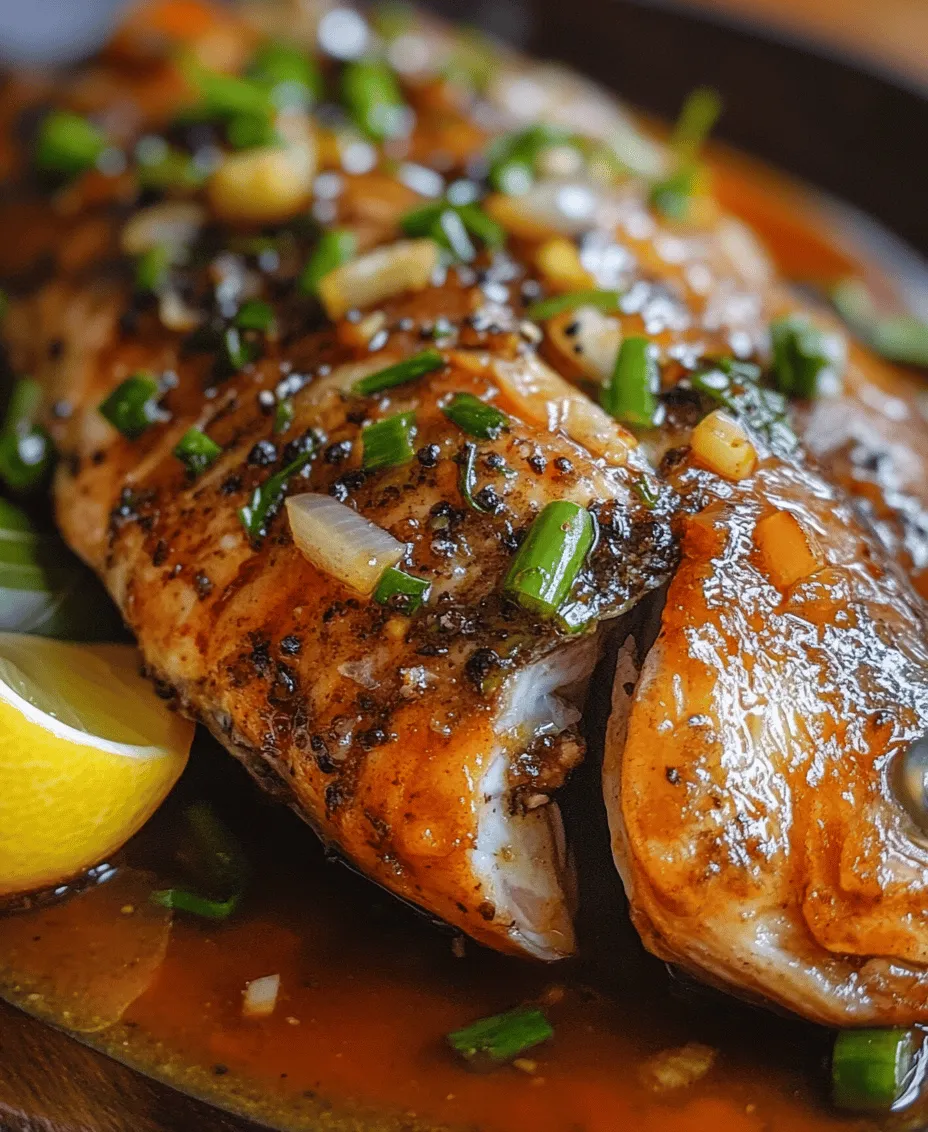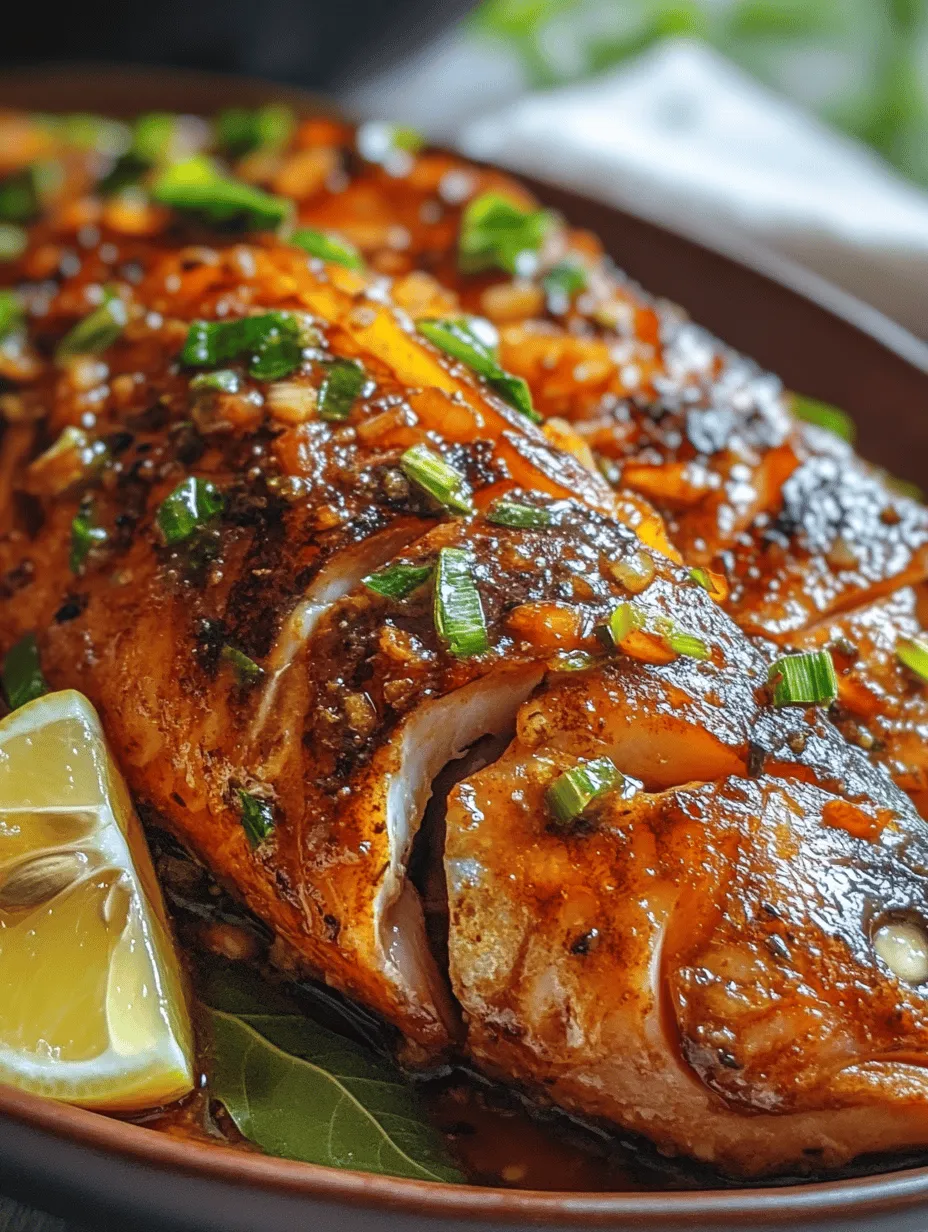Introduction
Bangus, also known as milkfish, holds a cherished place in Filipino cuisine, celebrated not only for its delectable taste but also for its nutritional benefits. This versatile fish is often featured in a variety of dishes, showcasing its ability to absorb flavors while maintaining its unique texture. Among the many preparations of Bangus, one stands out for its comforting and flavorful profile: Bangus Spanish Sardines. This dish combines the hearty essence of Bangus with the bold flavors of spices, resulting in a meal that is both satisfying and deeply rooted in Filipino culinary traditions.
Bangus Spanish Sardines not only serves as a delicious meal but also reflects the rich cultural heritage of the Philippines. It encapsulates the ingenuity of Filipino cooking, transforming simple ingredients into a dish that is both comforting and celebratory. As you savor each bite, you’ll experience the warmth of home and the love that goes into traditional Filipino cooking.
In this article, we will delve into the nuances of Bangus Spanish Sardines, exploring its ingredients, preparation methods, and the cultural significance behind this beloved dish.
Understanding Bangus (Milkfish)
Description of Bangus
Bangus is a unique fish known for its silvery skin, tender white flesh, and distinctive flavor. It is the national fish of the Philippines and is highly regarded for its rich taste and versatility in cooking. The flesh of Bangus is both flaky and firm, making it ideal for various preparation styles, from grilling to frying and stewing. Nutritionally, Bangus is a powerhouse, rich in Omega-3 fatty acids, protein, and essential vitamins and minerals, contributing to a balanced diet.
This fish is often characterized by its delicate flavor, which can be enhanced with various seasonings and cooking techniques. Its ability to absorb flavors makes it a favorite among chefs and home cooks alike, allowing for endless culinary creativity.
Historical Context
The historical significance of Bangus in the Philippines cannot be overstated. Found abundantly in Philippine waters, particularly in brackish environments, Bangus has been a staple food source for generations. It has been a vital part of Filipino diets, especially in coastal communities where fishing is a primary source of livelihood. The cultural ties to Bangus extend beyond its nutritional value; it represents a connection to the sea, the environment, and the traditions of Filipino fishermen.
As a symbol of Filipino identity, Bangus is often featured in family gatherings, festivals, and daily meals. Its popularity has led to various preparations, with Bangus Spanish Sardines being one of the most cherished. This dish not only celebrates the fish but also the culinary creativity that defines Filipino cooking.
Ingredients Breakdown
Creating the perfect Bangus Spanish Sardines requires attention to detail and the right ingredients. Each component plays a crucial role in building the dish’s flavor profile, culminating in a delightful meal that honors the traditions of Filipino cuisine.
Bangus
The star of the show is, of course, Bangus. When selecting your Bangus, freshness is paramount. Look for fish with clear eyes, shiny skin, and a mild ocean scent. Proper cleaning is essential; this includes removing the scales, entrails, and thoroughly rinsing the fish to ensure a clean taste. A well-prepared Bangus will set the foundation for a delicious meal.
Olive Oil
Olive oil is used generously in this recipe, not just for cooking but also for its health benefits. Rich in monounsaturated fats, it contributes to heart health and adds a rich depth of flavor to the dish. The oil serves as a base for sautéing the aromatics and helps to meld the flavors of the ingredients together.
Garlic and Onion
Garlic and onion are the aromatic backbone of Bangus Spanish Sardines. The combination of these two ingredients creates a flavorful base that enhances the overall taste of the dish. The caramelization of garlic and onion during the sautéing process brings out their natural sweetness, adding complexity to the flavor profile.
Long Green Chilies
For those who enjoy a hint of spice, long green chilies are an essential addition. These chilies provide a subtle heat that balances the dish without overpowering the delicate flavor of the Bangus. When cooked, they soften and release their essence, enriching the overall flavor.
Soy Sauce and Vinegar
The combination of soy sauce and vinegar is a hallmark of Filipino cooking, providing a beautiful balance of umami and acidity. The soy sauce adds depth and saltiness, while the vinegar contributes a tangy brightness that cuts through the richness of the fish. Together, they create a savory marinade that infuses the Bangus with flavor.
Black Peppercorns and Bay Leaves
Adding black peppercorns and bay leaves enhances the aromatic experience of the dish. The peppercorns introduce a warm, spicy note, while the bay leaves impart a subtle earthiness. These ingredients work in harmony to elevate the dish’s overall flavor profile, making each bite more complex and enjoyable.
Fresh Lemon or Calamansi
For the final touch, a squeeze of fresh lemon or calamansi rounds out the flavor. The acidity from the citrus brightens the dish, making it more vibrant and refreshing. This finishing touch brings all the elements together, ensuring a well-rounded and flavorful Bangus Spanish Sardines.
Preparation Steps for Bangus Spanish Sardines
Now that we have explored the essential ingredients, let’s dive into the preparation steps for creating Bangus Spanish Sardines. This dish is straightforward to make, but the key to success lies in the details.
Preparing the Bangus
Properly preparing the Bangus is crucial for achieving the best flavor and texture. Begin by cleaning the fish thoroughly under cold running water. Make a shallow cut along the belly, removing the entrails, and rinse again to eliminate any remaining impurities. After cleaning, it’s essential to pat the fish dry using paper towels. This step ensures that the seasonings adhere well and prevents excess moisture from affecting the cooking process.
Once cleaned and dried, season the Bangus generously with salt. This not only enhances the flavor but also helps to draw out excess moisture, creating a firmer texture. Allow the fish to marinate in the salt for about 15-20 minutes. This resting period is crucial as it allows the salt to penetrate the flesh, ensuring a well-seasoned end result.
Sautéing the Aromatics
The next step involves sautéing the aromatics, which is where the magic begins. In a large skillet, heat olive oil over medium heat. Once the oil is hot, add finely chopped garlic and onion. Sauté them gently, stirring frequently, until they become fragrant and translucent. This process usually takes about 3-5 minutes and is vital for developing the foundation of flavor in your Bangus Spanish Sardines.
As the garlic and onion cook, you will begin to notice their natural sweetness and aroma filling the kitchen. At this point, you can add the long green chilies, allowing them to soften and infuse their flavor into the oil.
Next, introduce the prepared Bangus to the skillet, ensuring that it is evenly coated with the sautéed mixture. The goal is to allow the fish to absorb the aromatic flavors while cooking through evenly.
Stay tuned for the continuation of this delightful recipe, where we will explore the remaining steps to create this flavorful Bangus Spanish Sardines, along with helpful tips for achieving the best results.

The Significance of Cooking Garlic and Onion to the Right Point
In the preparation of Bangus Spanish Sardines, the sautéing of garlic and onion is crucial. Properly cooking these aromatics not only enhances the base flavor of the dish but also sets the stage for the overall depth of flavor in the sauce. Garlic should be cooked until it turns golden brown, releasing its essential oils and creating a rich, fragrant aroma. Onions should be softened and translucent, ideally caramelized to bring out their natural sweetness. The right timing in this step ensures that the dish does not taste raw or bitter, contributing to a well-rounded flavor profile that complements the Bangus perfectly.
Cooking the Bangus
Explanation of Searing: Importance of Skin Texture and Flavor
The next step is to cook the Bangus. Searing the fish is a critical technique in achieving that signature crispy skin and enhancing its flavor. When the skin of the Bangus is seared properly, it forms a delightful crust that locks in moisture while providing a contrast to the tender flesh. This texture not only elevates the dish but also adds to the overall eating experience.
To begin, ensure that your cooking oil is hot enough before placing the fish in the pan. The goal is to achieve a golden-brown exterior without cooking the fish through entirely at this stage. The searing process will also help to develop a rich umami flavor that is characteristic of Spanish-style sardines.
How to Position the Fish for Optimal Cooking
When placing the Bangus in the pan, it is essential to position it skin-side down. This allows the skin to crisp up beautifully while the flesh cooks gently. Avoid overcrowding the pan; if you have multiple pieces, it’s best to cook them in batches. Overcrowding can cause the temperature to drop, leading to steaming rather than searing. Let the fish cook undisturbed for a few minutes until it releases easily from the pan, indicating that it has developed a nice crust.
Adding Flavor Enhancements
The Role of Each Ingredient in Building the Sauce
As the Bangus cooks, it’s time to enhance the flavors further by incorporating additional ingredients into the sauce. The classic combination typically includes soy sauce, vinegar, bay leaves, and peppercorns. Each ingredient plays a vital role:
– Soy Sauce adds salinity and depth.
– Vinegar introduces acidity that balances the richness of the fish.
– Bay Leaves infuse the dish with herbal notes.
– Peppercorns provide a gentle heat that rounds out the flavors.
Tips on Achieving the Right Balance of Flavors
To achieve the perfect balance, start by adding the soy sauce and vinegar in equal parts, adjusting based on your taste preferences. If you prefer a tangier sauce, increase the vinegar, while those who enjoy a saltier profile might lean towards more soy sauce. Always taste as you go, allowing the flavors to meld together before adding more of any ingredient.
Simmering Process
Explanation of the Simmering Technique and Its Purpose
After incorporating the sauce ingredients, it’s time to simmer the Bangus. Simmering allows the fish to absorb the flavors of the sauce while ensuring it cooks through evenly. This gentle cooking method prevents the fish from becoming tough, resulting in a tender, flavorful dish.
Importance of Flipping the Fish for Even Cooking
During the simmering process, flipping the Bangus halfway through is essential. This ensures that both sides of the fish absorb the sauce and flavors equally, resulting in a harmonized dish. Use a spatula to carefully turn the fish over, avoiding any breakage. Allow the fish to simmer for an additional 10-15 minutes, depending on the thickness of the fillets.
Reduction Technique
Explanation of Reducing the Sauce and Its Significance
Once the Bangus is cooked, it’s time to focus on the sauce. Reducing the sauce is a technique that concentrates the flavors, thickening the liquid and intensifying the taste. To do this, remove the Bangus and increase the heat to medium-high. Allow the sauce to boil gently until it reduces by about one-third, stirring occasionally to prevent burning.
How to Adjust Seasoning for Personal Taste Preferences
As the sauce reduces, taste it again. You may want to adjust the seasoning at this stage. If it tastes too salty, add a splash of water or additional vinegar to balance it out. If it lacks depth, a pinch of sugar or a dash of additional soy sauce can enhance the overall flavor. Remember, the sauce should complement the Bangus without overpowering its delicate taste.
Serving Suggestions
Ideal Accompaniments
Bangus Spanish Sardines can be served in a variety of ways. Traditionally, it pairs beautifully with steamed white rice, which absorbs the delicious sauce. A side of fresh vegetables, such as sautéed greens or a light salad, can provide a refreshing contrast to the richness of the dish. You can also serve it with a side of pickled vegetables to add a tangy crunch that enhances the overall meal.
Presentation Tips to Enhance the Dining Experience
For an appealing presentation, place the Bangus on a large platter, drizzling the reduced sauce generously over the top. Garnishing with freshly chopped parsley or cilantro adds a pop of color. Serve with a bowl of steaming rice on the side, and perhaps a small dish of soy sauce or vinegar for dipping.
Cultural Context of Serving Fish Dishes in Filipino Households
In Filipino culture, fish dishes hold a special place, often representing family gatherings and celebrations. Bangus, known as the “milkfish,” is a beloved staple in many households. Serving Bangus Spanish Sardines not only showcases the rich flavors of Filipino cuisine but also emphasizes the significance of sharing meals with family and friends.
Nutritional Value of Bangus Spanish Sardines
Overview of the Health Benefits of the Ingredients Used
Bangus Spanish Sardines is not only a delicious dish but also packed with health benefits. Bangus is a highly nutritious fish rich in omega-3 fatty acids, which promote heart health and reduce inflammation. The use of garlic and onion in the recipe also contributes to overall health, as they are known for their antioxidant properties and ability to boost the immune system.
Discussion on the Dish’s Nutritional Contributions: Protein, Healthy Fats, Vitamins, and Minerals
Each serving of Bangus Spanish Sardines offers a substantial source of protein essential for muscle growth and repair. The healthy fats from the Bangus contribute to satiety while providing essential fatty acids necessary for optimal body function. Additionally, the dish is rich in vitamins such as B12 and minerals like potassium and selenium, making it a nutritious choice for any meal.
Conclusion
Bangus Spanish Sardines is more than just a meal; it is a celebration of Filipino culture and culinary tradition. This dish encapsulates the richness of flavors and the joy of cooking, inviting anyone to explore the depths of Filipino cuisine. As you prepare and savor this dish, remember the love and care that goes into every step, from sautéing the aromatics to simmering the fish in a savory sauce.
We encourage you to try this recipe, allowing it to bring a taste of the Philippines into your home. Share it with loved ones, creating memorable moments around the dining table. The joy of cooking and sharing meals is a universal experience that transcends cultures, and Bangus Spanish Sardines is a perfect embodiment of that joy. Embrace the flavors and the warmth of this dish, and let it inspire your culinary adventures.


